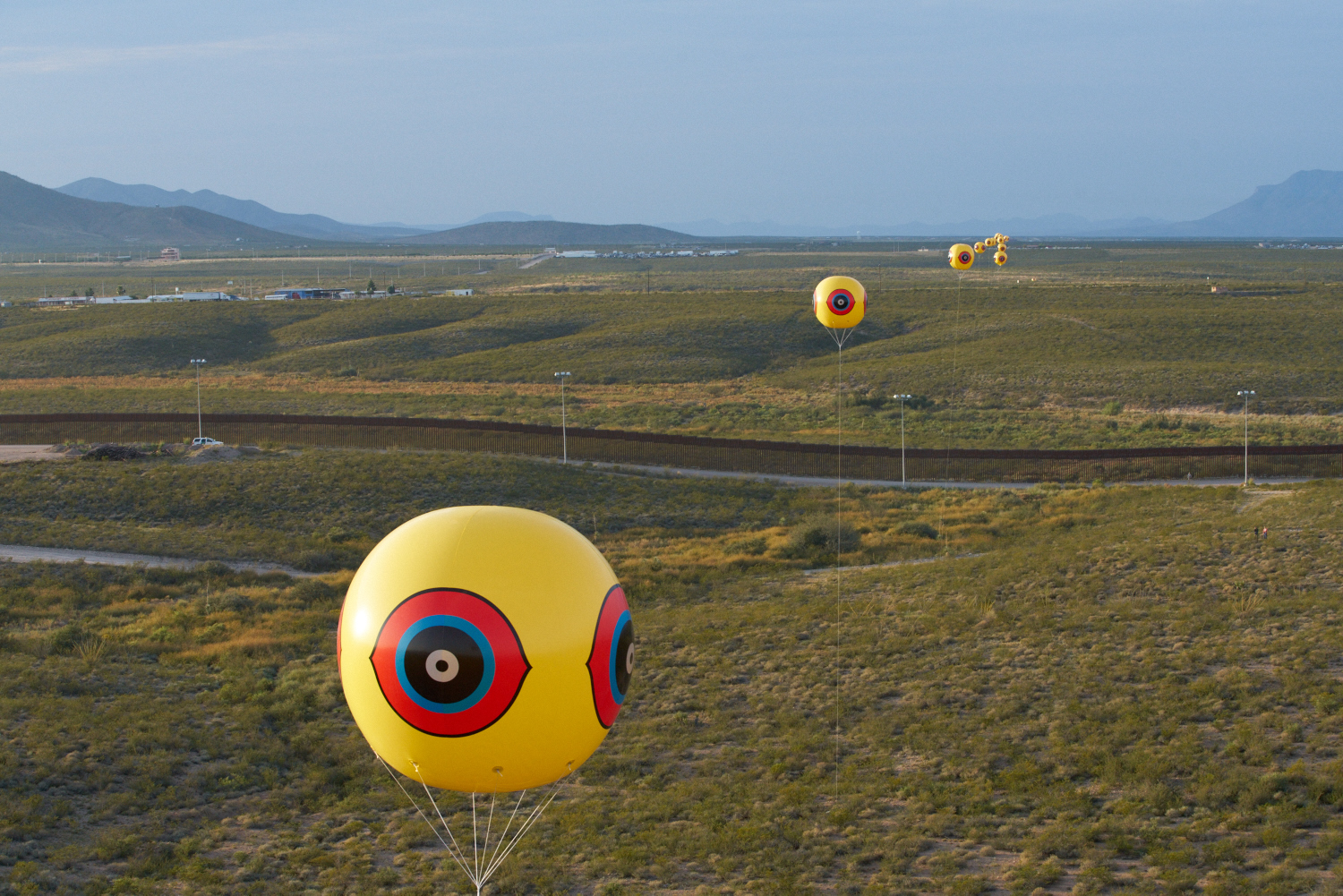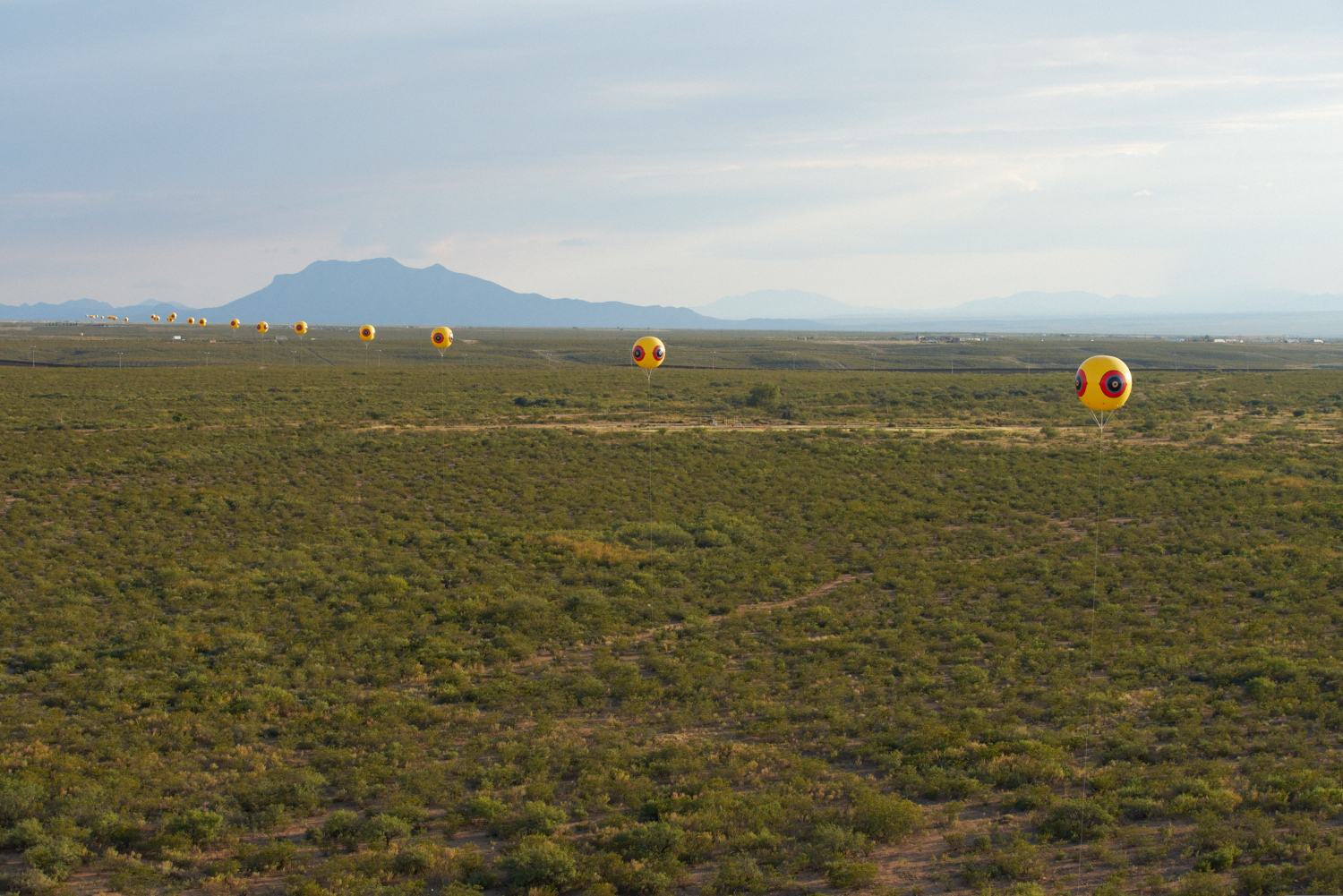Postcommodity's "Repellent Fence" Binds Two Fractured Cities Together

Postcommodity, “Repellent Fence” (2015). Land art installation and community engagement (Earth, cinder block, para-cord, pvc spheres, helium).
Installation view, U.S./Mexico Border, Douglas, Arizona / Agua Prieta, Sonora. Courtesy: the artists.
When Raven Chacon looked at the wall, he saw a challenge.
When Mark Adams looks at the wall, he sees a failure.
The wall — a utilitarian beast built out of dingy metal and rust-brown slats — carves through the shrubland to follow along the U.S.- Mexico border, cutting off pathways used by indigenous people and animals for centuries.
The wall — brown and faded, resembling a prison cell door more than an international border crossing — stands between the sister cities of Auga Prieta, Sonora and Douglas, Arizona, where it has separated the cities for decades.
“[We] wanted to dwarf this wall,” Chacon says.
“I see a failure of imagination,” Adams says.
“We wanted to show this north-south relationship, between indigenous people and between wildlife that have always migrated here.”
“A failure of intelligence. I see a huge cost of human suffering, of natural resources. A huge cost of money too.”
Chacon makes up one part of Postcommodity, a group of indigenous visual artists in the southwestern United States.
Adams is a member of Frontera de Cristo, a border ministry that serves the two cities, which are bisected by the wall which marks the U.S.-Mexico border.
For eight years, the artists worked on an installation that would shadow the fence and reconnect the border cities of Douglas, Arizona and Agua Prieta, Sonora — historically linked, now separated for nearly two decades.
For 17 years, Adams has watched how the border fence has changed the relationship of these two cities. He first arrived in the area shortly after the first wall was built. He says the two cities, linked together for more than a century, are now separated and suspicious.
“It was bridging these two communities, stitching together these towns that were divided by this militarized border,” Chacon says.
“It divided the two cities physically and psychologically ... it created [feelings of] fear, rejection. It was like a challenge,” he says.
The plan was ambitious, and the group knew they would not be able to complete it by themselves. They turned to help from those living in the sister cities, the very ones whose lives have been most affected by the wall.
When Adams hears from friends about Postcommodity, a group of artists who are working on a project to highlight the “futility” of the fence, he jumps at the chance to help.
“We were just happy that the community wanted us and included us in what they were doing,” he says.
“I was very excited that they were interested in doing something,” he says.

Postcommoity, Repellent Fence (2015). Land art installation and community engagement (Earth, cinder block, para-cord, pvc spheres, helium).
Installation view, U.S./Mexico Border, Douglas, Arizona / Agua Prieta, Sonora. Courtesy: the artists.
On a Saturday morning in October, at around sunrise, a small army of artists and volunteers erected Repellent Fence — a three-kilometre-long string of 26 tethered balloons, each 10 feet in diameter, that crossed over the border, connecting Sonora with Arizona.
“I didn’t realize the impact it would have … the hope that it brought, “ says Adams.
Birds vs. borders
“It was definitely our most ambitious project so far," says Kade Twist, another Postcommodity artist.
The idea for Repellent Fence came from an unusual place — Twist’s backyard. Years ago, his wife bought a balloon painted with a "scare-eye” symbol, designed to frighten birds away from their fig trees.
The balloons were an utter failure at protecting the fruit. But the bright reds and yellows used to paint the eye stuck with Twist. The colours and the symbol linked closely to those used in Indigenous North American art.
The idea stuck in Twist’s mind, burrowing in for more than a decade. Since then, the group has completed many projects together, including a residency at The Banff Centre in January 2014. The scare-eye motif has shown up in their work before, in installations in Winnipeg and Dallas. But never to the scale of Repellent Fence.
The artists felt the scare-eye symbol was a natural fit when it came to pointing out the “absurdity of the border fence,” according to Chacon. He explained that for many Indigenous cultures, birds are seen as “spiritual mediators and communicators” in conflicts.
As well, they are one of the few types of wildlife that aren’t hindered by the fence.
“One thing a border wall can’t do is stop migratory birds,” he says.
‘Hope and vision’
The original plan was to have the balloons spread out along the border, mocking the wall. But as the group began to talk with people living on both sides of the border, they decided the idea needed to change. Repellent Fence needed to run north-south, as a nod to the broken connection between the two communities.
For that, they called on the help of locals, like Adams. His ministry helped the artists navigate the issues that come with launching a project that straddled two counties. He also helped shuttle volunteers back and forth across the border to help fill and launch the balloons.
Even though Adams was on the frontlines of the effort to put up the Repellent Fence, he says he wasn’t prepared for the moment when he finally saw the bright yellow balloons towering over the brown, dingy wall.
“It gave us hope and vision,” Adams says.
“Day in and day out, we are bombarded by images of the wall. We can’t get away from it … [it] revealed the futility of the wall. Walls have fallen.”
While Repellent Fence only stood against the sky for a few days, the artists believe that the impact on both Douglas and Agua Prieta will last much longer. They hope the installation will help people get past the fence that keeps the two towns divided.
“What was really shocking was the emotional investment from people in both cities … it seemed to transform people,” Twist says.
“I’m a terrible cynic, but there was a real, legitimate transformation there.”
Adams, too, is hopeful. While Postcommodity's fence was only temporary, it did help those living in the shadow of the border fence see a day imagine a day when Douglas and Agua Prieta would no longer be divided.
”It was like a banquet that nourished us for the work we have chosen.”
Postcommodity was lead faculty for the Visual + Digital Arts residency Global Positioning System or Hacking the Coordinates to Enable Shapeshifting and Shadow Networks in 2014 from January 13 – February 21.